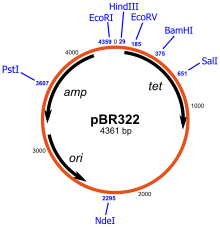
pBR322 is a plasmid and was one of the first widely used E. coli cloning vectors. Created in 1977 in the laboratory of Herbert Boyer at the University of California, San Francisco, it was named after Francisco Bolivar Zapata, the postdoctoral researcher and Raymond L. Rodriguez. The p stands for "plasmid," and BR for "Bolivar" and "Rodriguez."
pBR322 is 4361 base pairs in length[1] and has two antibiotic resistance genes – the gene bla encoding the ampicillin resistance (AmpR) protein, and the gene tetA encoding the tetracycline resistance (TetR) protein. It contains the origin of replication of pMB1, and the rop gene, which encodes a restrictor of plasmid copy number. The plasmid has unique restriction sites for more than forty restriction enzymes. Eleven of these forty sites lie within the TetR gene. There are two sites for restriction enzymes HindIII and ClaI within the promoter of the TetR gene. There are six key restriction sites inside the AmpR gene.The source of these antibiotic resistance genes are from pSC101 for Tetracycline and RSF2124 for Ampicillin.[2]
The circular sequence is numbered such that 0 is the middle of the unique EcoRI site and the count increases through the TetR gene. If we have to remove ampicillin for instance, we must use restriction endonuclease or molecular scissors against PstI and then pBR322 will become anti-resistant to ampicillin. The same process of Insertional Inactivation can be applied to Tetracycline. The AmpR gene is penicillin beta-lactamase. Promoters P1 and P3 are for the beta-lactamase gene. P3 is the natural promoter, and P1 is artificially created by the ligation of two different DNA fragments to create pBR322. P2 is in the same region as P1, but it is on the opposite strand and initiates transcription in the direction of the tetracycline resistance gene.[3]
- ^ Watson, N. (1988). "A new revision of the sequence of plasmid pBR322". Gene. 70 (2): 399–403. doi:10.1016/0378-1119(88)90212-0. PMID 3063608.
- ^ Balbás P, Soberón X, Merino E, Zurita M, Lomeli H, Valle F, Flores N, Bolivar F (1986). "Plasmid vector pBR322 and its special-purpose derivatives--a review". Gene. 50 (1–3): 3–40. doi:10.1016/0378-1119(86)90307-0. PMID 3034735.
- ^ "pBR322 Nucleotide Sequences, NCBI Sequence Viewer v2.0". 30 September 2008.